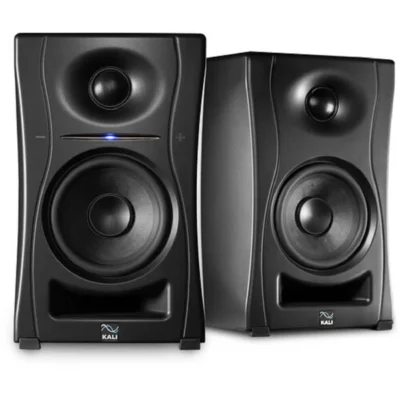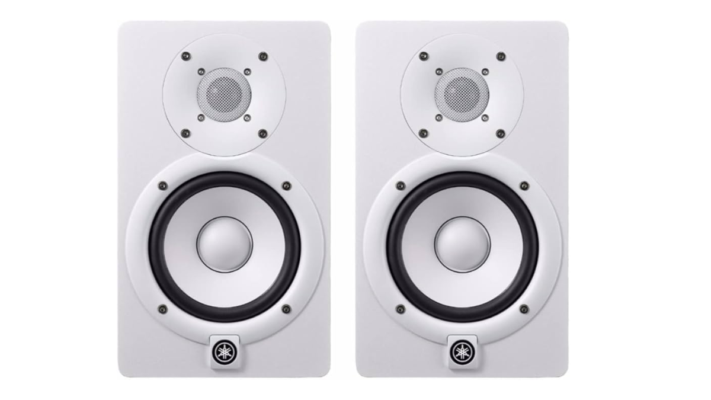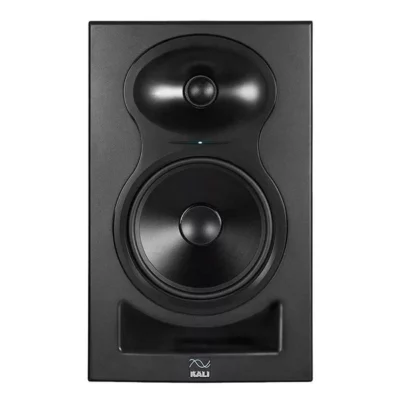Last Updated on March 24, 2025 by Muisc Pro Editorial Team
If providing quality audio content is your thing, then studio monitors are likely to be right at the top of your list of must-haves.
Anyone involved in audio production knows how important these high-tech pieces of equipment are to deliver accurate, precise content.
Whether you are just getting into the market or are already a seasoned pro, investing in some top-notch studio monitors is a must!
That’s where we can help! Here are our favourite studio monitors, tried and tested by our tech team and painstakingly curated based on performance, frequency response, andd sound representation.
Audio-Technica AT-SP3X
The Audio-Technica AT-SP3X is a pair of powered bookshelf speakers aimed at compact, modern home setups. Its design is minimalist, with a one-piece build and rounded corners, including rubber feet for stability and a 6.6-foot speaker cable for easy placement. It features 3-inch woofers and 1.1-inch tweeters, tuned by a built-in DSP for rich, full-range audio, particularly noted for its bass-heavy sound. Connectivity options include dual RCA jacks for wired connections and Bluetooth with multipoint pairing, making it versatile for use with turntables, computers, or smartphones. It’s designed for affordability and convenience in home environments.
Yamaha studio monitors are renowned for their accuracy, reliability, and balanced sound reproduction, making them a top choice for producers and audio engineers. Yamaha’s legendary HS series is built on the iconic NS-10s, lending a new twist to a legacy of trusted performance.
Yamaha HS5 Studio Monitor
Designed for small and medium-sized spaces, this compact powerhouse carries a 5-inch woofer and 1-inch tweeter and produces 60 watts over a range of 48 Hz to 30 kHz. The biamped design also allows a separate amp for the woofer and tweeter, minimizing distortion, while the low-resonance cabinet maintains clarity.
Many seasoned users appreciate the crisp, midrange response combined with a tight bass but a few users have commented that in larger spaces, the bass lacks some punch. A sub should fix that!
Yamaha HS8 Studio Monitor
The HS8 offers a smooth, balanced sound, solid build, and is designed for medium to large rooms. It has an 8-inch woofer and a 1-inch tweeter, providing a department 100 watts over 36 Hz to 30,000 Hz.
Its rear bass port and room control settings help optimize sound in different studio environments. Whether you’re producing music, editing podcasts, or mastering tracks, the Yamaha HS8 provides a detailed, uncolored sound for professional results. With clear highs, tight mids, and deep, controlled bass, many music producers use it in the studio for various genres, from rock to EDM.
Yamaha HS10
One for the pros, the Yamaha HS10 packs a real punch for big studio setups. The 10-inch woofer and 1-inch tweeter push a whopping 150-watt wide over a frequency range of 30 Hz to 30 kHz. It includes XLR and ¼-inch inputs, along with adjustable low/high cutoff filters and a phase switch, allowing seamless integration into any studio setup.
The deep bass produced makes it unnecessary to use a sub, and many professionals rave about its power, detail, and performance in larger spaces.
Kali Audio
Hailing from Southern California, Kali Audio is a fast-growing brand known for producing high-quality, affordable studio monitors with precise sound reproduction. Their LP-Series and IN-Series monitors offer flat frequency response, low distortion, and powerful bass.
Kali Audio Project Lone Pine LP-UNF

The Kali Audio Project Lone Pine LP-UNF is a pair of ultra-nearfield studio monitors priced at $299, perfect for small studios. With a 4.5-inch woofer and 1-inch tweeter powered by 160W, they deliver clear sound across a 54 Hz to 21 kHz frequency response and a 103 dB max SPL. They offer versatile connectivity, including USB-C, Bluetooth 5.1, TRS, and RCA, plus boundary EQ for flexible placement.
Compact and modern, these monitors are highly praised for their clarity and affordability, making them an excellent choice for budget-conscious producers and home studio setups.
Kali Audio LP-6
The Kali Audio LP-6 is known for its accurate sound reproduction and affordability. With a bi-amped Class D amplifier, boundary EQ controls, and a 3D waveguide for improved imaging, the LP-6 offers professional-grade performance at a budget-friendly price.
With 100 watts, 6.5-inch woofers, and 1-inch tweeters, it covers a range of 35 Hz – -25,000 Hz and has a flat response and room correction features. However, it will struggle in large rooms without a sub and is more suited to smaller rooms.
Kali Audio IN-8

Built for medium to larger rooms, the IN-8 is equipped with an 8-inch woofer and a 1-inch tweeter, and includes 150 watts, and a range of 30-25,000 Hz. Additional imaging capability is provided thanks to the co-axial design and boundary EQ settings help it adapt to your space.
Users love the deep bass and ringing highs, but room treatment really helps unleash its full potential. This wallet-friendly option is a surprisingly good bang for your buck if you want a sturdy, reliable workhorse for a large space without breaking the bank.
Genelec
When it comes to studio monitors, Genelec needs no introduction. This exceptional Finnish brand is known for its exceptional accuracy, durability, and innovative designs.
Genelec’s Smart Active Monitoring (SAM) technology optimizes sound for different environments, ensuring consistent, high-quality audio performance for mixing, mastering, and broadcast applications worldwide.
Genelec 8030

The bestselling Genelec 8030 is designed for small and mid-sized spaces. Consisting of a 5-inch woofer and 1-inch tweeter, it features 100 watts and a 45 Hz – 20,000 Hz frequency range. Like other models in “The Ones” series, its coaxial driver and minimal diffraction enclosure provide pristine imaging and low distortion.
Customers are calling this a mastering dream, raving about its clarity and build quality. It might cost a tad more than other models, but its excellent value for money and its small size is a plus for some arrangements.
Genelec 8040
If you need to go big, check out the Genelec 8040. With a 6.5-inch woofer and a 1-inch tweeter, it unleashes 150 watts through a frequency range of 35 Hz – -20,000 Hz. With 90W bass and 90W treble amplification, the 8040 provides clear highs, tight mids, and deep lows.
Room response controls help its incredible performance in large rooms, and customers have raved about its power and precision. Ideal for mixing, mastering, and broadcasting, the Genelec 8040 is an excellent choice for serious producers.
JBL
From Los Angeles, California, JBL is a globally recognized brand known for its high-quality, budget-friendly audio equipment. Their 3 Series studio monitors are popular for accurate sound reproduction, deep bass, and wide sweet spots, making them ideal for mixing and mastering.
With advanced technologies like Image Control Waveguide and JBL Slip Stream™ ports, JBL monitors deliver clear, balanced, and professional-grade audio performance for studios of all sizes.
JBL 305P MKII

The budget-friendly JBL 305P MkII is meant for smaller spaces. With a 5-inch woofer and 1-inch tweeter, it cranks 50 watts over a frequency response of 45Hz to 40kHz. Featuring JBL’s Image Control Waveguide, it offers an expansive soundstage and accurate stereo imaging.
The dual Class-D amplifiers provide 82 watts of power, ensuring clear, distortion-free audio at any volume, and its custom boundary EQ settings help optimize sound for different studio environments. Affordable yet professional, this studio monitor will suit small setups and home studios!
JBL 308P MKII
With an 8-inch woofer and 1-inch tweeter that cranks out 00 watts over 38Hz to 40kHz, this studio monitor is more suited to mid-sized rooms. The larger woofer and solid builds means a more spacious bass field, and it does an outstanding job in moderate sizes but struggles in large ones.
Also powered by dual Class-D amplifiers (112W total power), it ensures clean and distortion-free sound at all volumes. With custom boundary EQ settings, the 308P is an excellent choice for the more serious audio creators.
Focal
French brand Focal is known for its excellent studio monitors with exceptional precision and clarity. Designed for accurate mixing and mastering, Focal’s proprietary Flax and Beryllium drivers ensure low distortion and natural sound reproduction.
Used by professionals worldwide, Focal monitors provide excellent imaging and depth, making them a top choice for music production, film scoring, and broadcasting.
Focal Solo6 Be

Designed for mid-sized rooms, the Focal Solo6 includes a 6.5-inch woofer and 1-inch beryllium tweeter, delivering 100 watts across the 40 Hz – 40,000 Hz range. The bi-amplified design keeps the sound precise, and the sleek, elegant design is a hit with audio producers of all levels.
This model isn’t the cheapest, but the outstanding performance more than makes up for the heftier price tag. Delivering an expansive soundstage that outshines its competition, it plays without audible distortion and has excellent dynamics.
Focal Twin6 Be

If you have a larger studio, check out the Focal Twin6 Be. With two 6.5-inch woofers and two 1-inch tweeters, this monster delivers 200 watts from 35 Hz to 40,000 Hz.
Made with top-notch finishing, the Twin6 is designed for professional nearfield or midfield applications and would suit the serious producer.
Amphion
Finnish brand Amphion is renowned for clarity, precision, and natural sound production. Their studio monitors feature low-distortion drivers and passive radiators, delivering transparent, precise audio.
Amphion One15

The One15 is particularly good for small rooms with a 5-inch woofer and 1-inch tweeter with a rating of 50 W and a 45 Hz – 25,000 Hz range. With its neutral sound and low resonance cabinet, it aims for superior accuracy and has earned its place among mixing engineers who love it.
While it might struggle in larger spaces, its nearfield performance is hard to beat.
Amphion Two18

With an 8-inch woofer and a 1-inch tweeter with a capacity of 100 W, the Two18 plays between 35 Hz – 25,000 Hz. Designed for mid to large rooms, it delivers crisp, clear sound and is renowned for its low-distortion sound, even at low volumes.
This model isn’t the more affordable, but it would suit serious producers that are prepared to invest in top-quality equipment for impeccable performance.
From Seattle, Washington, Mackie is the primary product line of Loud Technologies. Popular among musicians, producers, and podcasters, Mackie provides reliable, cost-effective solutions without compromising sound quality. With a reputation for rugged build and great performance, Mackie remains a hot favourite in the audio industry.
Mackie CR3.5BT 3.5″ Powered Studio Monitors

The Mackie CR3.5BT is a compact, budget-friendly option for beginners and small setups, featuring a 3.5-inch woofer and 1-inch silk-dome tweeter. It includes a tone control knob for sound shaping and a location switch for optimizing performance in desktop or bookshelf modes.
Connectivity options include RCA, 1/8-inch aux, and Bluetooth, enhancing versatility for wireless streaming. It’s designed for affordability and suitability for small rooms, desktop use, gaming, and casual listening, combining studio-quality sound with sound shaping features for content creators and hobbyists.
Mackie MR524 5-inch Powered Studio Monitor

The Mackie MR524 is designed for professional studio use, featuring a 5-inch polypropylene woofer and a 1-inch silk-dome tweeter in an all-wood cabinet with internal bracing. Its logarithmic waveguide provides an ultra-wide listening sweet spot and enhanced stereo imaging, while Acoustic Space controls allow frequency response adjustments to match studio environments. It offers balanced XLR and unbalanced RCA inputs, making it excellent for studio work.
Top Picks According To Room Size
Getting the right studio monitor depends greatly on your room size. Too large a monitor will overwhelm a small room, but too small a monitor might have a dismal performance in larger spaces. Here’s our favourite picks according to your room size, so be sure to shop accordingly!
Best for Small Rooms: Yamaha HS5
If your room is under 150 sq ft, the Yamaha HS5 might just be your go-to. With a 5-inch woofer working on a 60-watt thrust, the Yamaha HS5 douses any possibility of bass buildup in small quarters. It doesn’t go particularly deep in the lows but it will allow for precise control in nearfield mixing.
Best for Medium Rooms: Kali Audio IN-8
King (or Queen!) of the mid-size rooms, the Kali Audio IN-8 will suit rooms from 150 to 300 sq ft. With deep lows and crisp highs, the IN-8 is an excellent value buy for those looking for an affordable, versatile option.
Best for Large Rooms: Focal Twin6 Be
For rooms larger than 300 sq ft, the Focal Twin6 reigns supreme. The two 6.5-inch woofers pump out an impressive 200 watts of power for the ultimate performance in larger spaces.
Final Thoughts on the Best Studio Monitors in 2025
From industry giants like Yamaha, JBL, and Genelec to designer brands like Amphion and Focal, selecting the best studio monitor comes down to your needs, budget, and room size.
One thing’s for sure: investing in high-quality monitors ensures accurate sound reproduction, balanced frequency response, and precise mixing and mastering.







